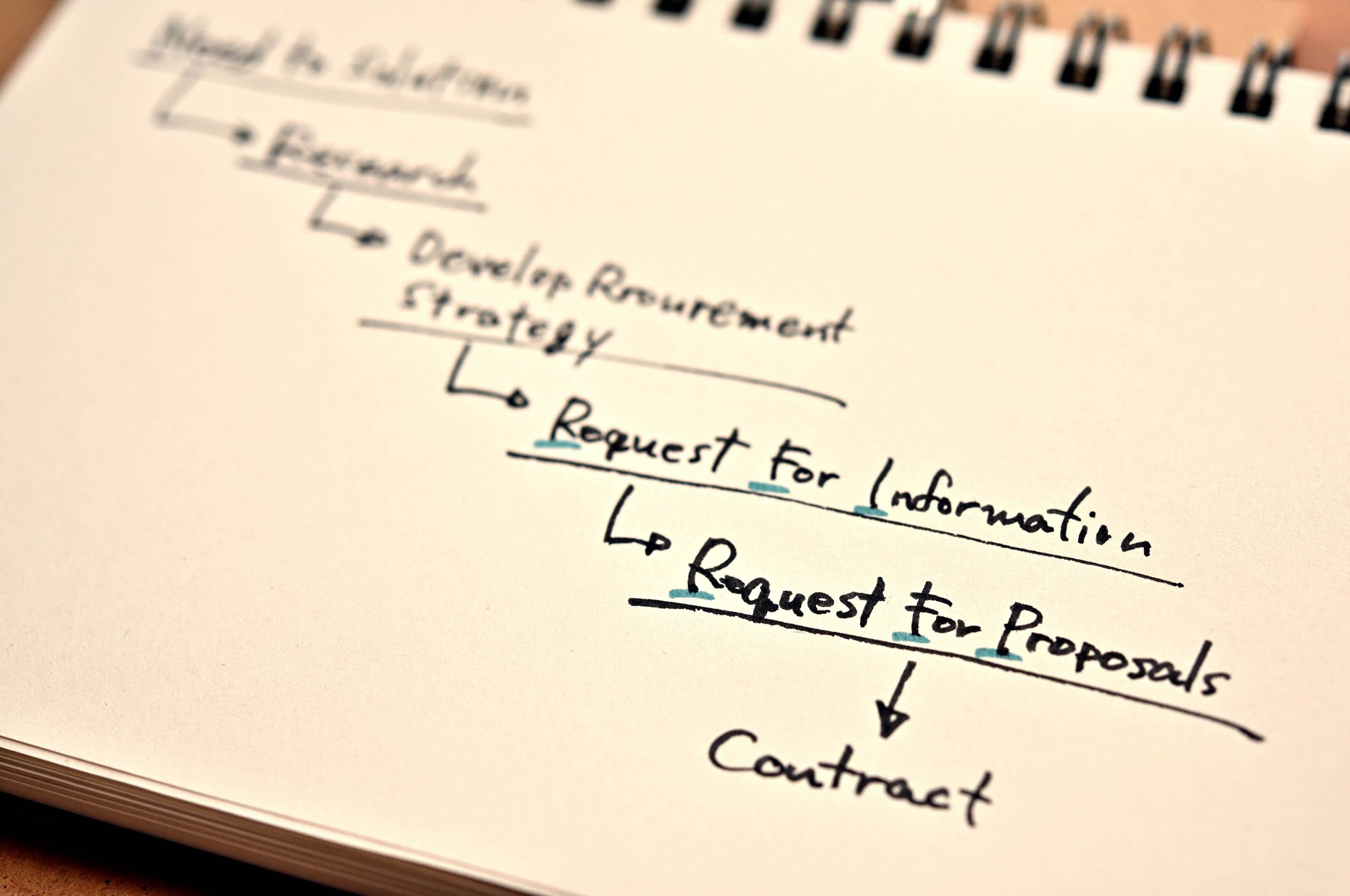RFP, RFI, RFX and other Enterprise B2B Sales Proposal Documents
RFP (Request for Proposal) and RFI (Request for Information) documents are two of the most common forms of document requests that are encountered in enterprise sales and B2B sales. Further in the procurement process you will also encounter the requirement for statement of work documents.
Here we will unpack each of these types of documents and understand how you can leverage IdeaFORGE® and sales enablement strategies to effectively automate and transform the way your sales team completes RFP, RFI, and Statement of Work (SOW) documents.
Let’s first explore what is an RFP, what is an RFI, and the difference of RFP vs RFI.
What is an RFP
A Request for Proposal, also known as an RFP, is a procurement document that requests a number of vendors to submit a bid and proposal to the organization (business, agency, non-profit, or government) interested in procurement of a product, service, commodity, or other type of asset.

An RFP will formally define a set of requirements and goals for a project and outline the evaluation criteria an award will be based upon. The document will often include an extensive list of qualification questions that vendors will be expected to answer. Vendors will provide written responses to these questions as part of the bidding process. You can think of an RFP like a questionnaire for your service.
Purpose of RFPs
The purpose of an RFP is to easily allow an organization to identify the most qualified vendor who meets the most criteria requirements at the best price. The evaluation process for an RFP is where IdeaFORGE® can play a massive supporting role within your organization. IdeaFORGE® acts as the Content Encyclopedia® within your organization, organizing all of your critical information into Modular Component IdeaBlocks. Each IdeaBlock focuses on answering a single important question, and can do so in any media format. There are many benefits to organizing information using IdeaFORGE® but one of the early benefits recognized is the ability to use IdeaFORGE® as a solution to support your RFP tool.

Because each IdeaBlock contains an answer to a single question, once your organization has a critical mass of information loaded into IdeaFORGE, one of the ways that information can be leveraged is to output the content in support of an RFP tool. IdeaBlock content is easily organized and always up-to-date, so your organization can benefit from a single source of truth for your valuable RFP answers without having to manage and maintain another source of information.
The RFP Process begins with an organization drafting their request for proposal by identifying the project scope and the critical questions that must be answered by each vendor. Vendors (the bidders) will be notified of the proposal or be able to access it through a RFP database or RFP service and submit feedback on the proposal’s requirements and scope based on subject matter expertise. Once the RFP has been finalized, the final proposal will be issued to the bidders. The bidders will submit their proposals to the organization including the answers to the questions and pricing. Downselection will occur where only the top candidates for the RFP bid are chosen to move to the next phase of the process. The organization who sent out the RFP will then ask the remaining vendors to submit a best and final offer (BAFO) before awarding the contract. The winner is then presented with the contract by the organization.
Throughout the RFP process, one of the most critical stages is getting through the initial evaluation stage. This requires both solution fit and an ability to easily articulate the value your solution brings to solving the critical questions being asked in the RFP.

IdeaFORGE’s methodology for answering customer’s critical questions through IdeaBlocks beings an intrinsic benefit in the form of high quality written answers. Because IdeaBlocks are multi-purposed, and used across many different parts of the organization, they have the benefit of being deeply thought out and polished. This is because each department is able to optimize and streamline their content creation requirements and unify the process of content creation under the single source of truth which is IdeaFORGE. Now your teams will be able to work together to craft the best quality answers to each major customer question, allowing teams to draw upon the expertise of sales, marketing, and technical expertise to write each IdeaBlock answer.
Faster RFPs and Automation
The substantial reduction in cost and wasted employee time will translate into cost savings and efficiency, with the added benefit of having an incredibly powerful arsenal of answers to customer’s critical questions without having to scramble to find the answers at the last minute. The speed, efficiency, and higher quality content delivered in the RFP will impress the procurement team and built trust and confidence in your organizations ability to deliver.

Why RFPs are Important
One key point to remember about the RFP process is that the RFP is the first time the customer is being exposed to how your organization operates. It’s assumed that no organization will be more “on their game” than when trying to win new business and is most incentivized to pull out all the stops. If your RFP looks disorganized or of low quality, this will not reflect well on your brand or reputation. The RFP process is all about building trust with the customer from the beginning.

On the customer’s side, the RFP is designed to provide a complete and thorough roadmap for project requirements and inspire open debate and competition to drive down the price of the solution. Price is a key factor, but it is not the only award criteria, and this is why having a thorough and quality proposal is key.
RFPs and Statements of WORK
A request for proposal submission by a vendor will often also include a statement of work which will outline the process by which work will be completed, and include actions, timelines, and roles and responsibilities for both the customer and the vendor. Most proposals will also include information about the vendor’s business, reputation, and other organizational information that is provided with the goal of building trust with the customer. This is another area where IdeaFORGE® can provide support. Functioning as the roadmap for content and content strategy, IdeaFORGE® can make it easy for organizations to quickly find and share the relevant information within their proposal, and further impress the customer with a variety of media formats like slide deck presentations or videos.
RFP Tools and RFP Software Collaboration
In enterprise sales and B2B sales, RFP and RFI documents are a big task and a team effort, often requiring many different departments to be involved to ensure accurate information is being provided to the customer, and that the vendor can truly deliver on the commitment.
Quality collaboration and a strong technology for centralizing all critical information is key to efficiency. Division of responsibilities should be broken down by expertise – for example, a marketing person should not be responsible for writing intricate technical details about a solution, and a technical subject matter expert should not be required to talk broadly about the organizations place in the market (this should be the role of the marketing professional). Effectively separating these roles will lead to a higher quality product that can be delivered faster.

When collaborating, using some type of RFP tool or RFP software to facilitate the process will be helpful, but also keep in mind that most of the information found within those tools should be double checked and validated as it may not be up-to-date. The best setup for an enterprise sales or B2B sales technology stack would be to leverage an RFP tool and have that data be fed into the tool from IdeaFORGE. By allowing IdeaFORGE® to act as that single source of truth to feed all major business investments, your teams will be able to confidently know the information is up to date, and easily delegate specific IdeaBlock content creation to the most experienced person in that area of business.

RFP vs RFI
A Request for Information or RFI is similar to the RFP process, but it comes at an earlier stage in the procurement process. Often times a customer will send out a request for information to a number of vendors to learn more about the solution or the space the solution operates in. An RFI is a great opportunity for a vendor to make a compelling argument as to why the customer should take this need seriously and why they are the best solution. An RFI, is a preliminary document that is shorter and designed to get general information from potential vendors, while an RFP is a longer document that a company requests from vendors to get detailed understanding of a vendors offerings and costs for a specific service.

Most RFI will include:
- An outline of the requirements and needs (to include goals and objectives)
- Background information on the need
- A list of qualification and credentials desired
- Information about the desired outcome
- The evaluation criteria for the vendor
- The deadline for submission
Like any quality story, your response to the RFP or RFI should follow a structure. Remember that you are telling a story, and the storybuilding process must be logical, concise, and ease to follow, and this is especially critical in the statement of work. The Statement of Work is your project narrative. The statement of work should be structured with a clear beginning, middle, and end and walk the customer through the process step by step.
Using IdeaBlocks it is easy to build a statement of work that follows an easy to understand structure, as each key piece of information can be easily ordered step by step.


